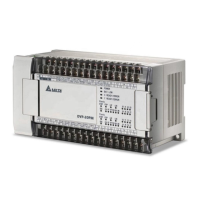9 Electronic Cam
【Program】
Create the first E-CAM data
Set up length of Master
Set up length of Slave
Set up length of sync area
Set up magnification ratio
Set up max magnification of speed
Set up acceleration curve
Set up CAM curve
DFLT
K1
M100
DMOV K1000 D100
DFLT
K10
D108
DMOV
K10000 D0
DMOV
K333 D102
DMOV K200 D104
MOV
K0
D110
MOV
H0
D111
DTO
K100 D0
D100 K7
D106
RST
M100
Borrow the data setting of previous E-CAM curve
Create the second E-CAM data
Set up length of Slave: 3334(pulse)
Create the third E-CAM data
Borrow the data setting of previous E-CAM curve
M101
MOV
H8000 D111
DTO
K100 D0
D100 K7
RST
M101
M102
DMOV
K334 D102
DTO
K100 D0
D100 K7
RST
M102
MOV
H8000 D111
9.4.2.4 Electronic Cam Data for Cutting Thick Material
In above rotary cut application, there is only one contact point for the cutter and the material, regardless
of the thickness of the material. In this way, only one synchronizing point is required when designing the
electronic cam. For thick material cutting, such as soap or steel plate, the velocity relationship between
cutter dropping and the material moving should be considered. When the material enters the sync area,
the material moving speed will equal to the moving speed of cutter, ensuring that the cutting plane is flat
and vertical to the conveyor. The below diagram illustrates the operation angles between the cutter the
material. V1 is the material moving speed; V2 is the cutter dropping speed; and the grey curves indicate
sync area (cutting area). When the thickness of material is equal, the contact angle between the cutter
and the material (angle θ) is a fixed value. In addition, the cutting angle α varies during the cutting
process. The velocity relationship can be described by the equation below:
)sin(
1
1
2
V
V
.
According to the diagram below, the cutter rolls through non-sync area and syn area. In sync area, the
horizontal moving distance (L) of the cutter should be the same as the moving distance of the material,
and the horizontal moving distance can be obtained by the equation:
sincos RRL
. In non-sync
DVP-20PM Application Manual
9-41

